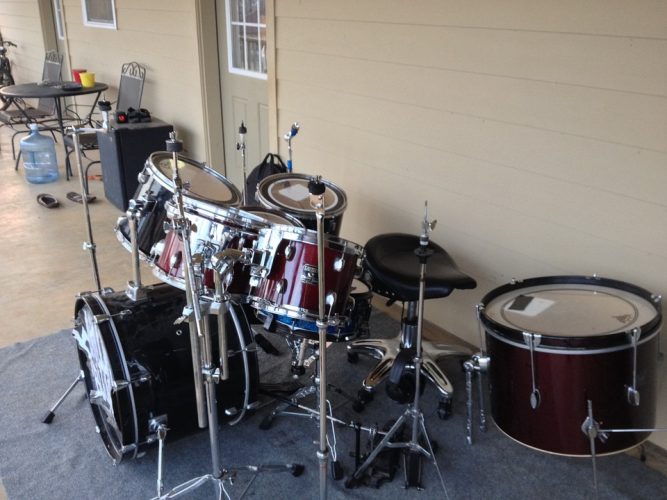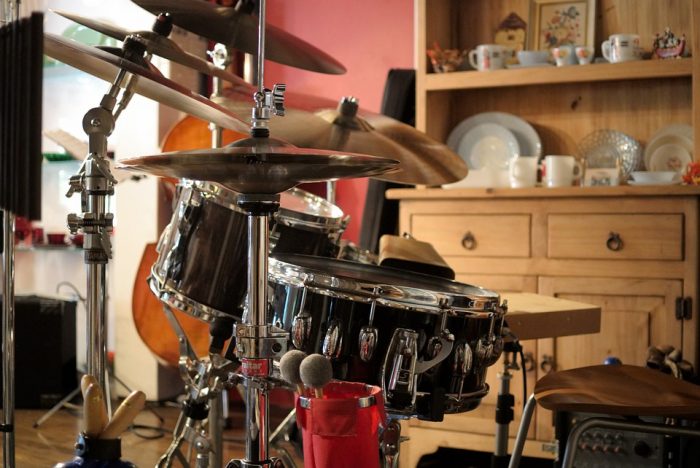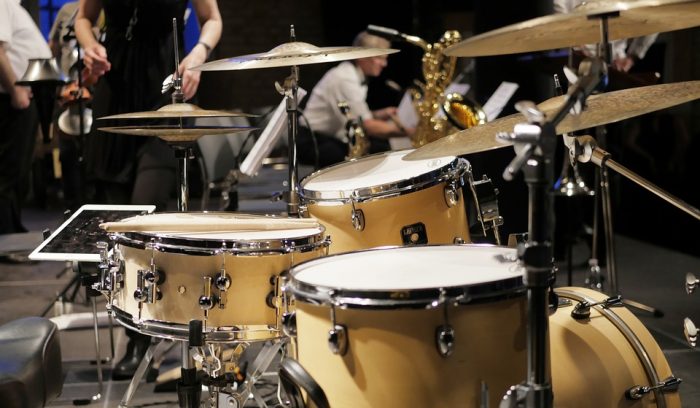By David E. Libman
Most of us like to think we are not overly materialistic, but whom are we kidding? Certain purchases provide us with an almost spiritual level of fulfillment. Among them: your first car, first personal computer, first smart phone, and, most importantly, first drum set. Yes, playing drums is about the music, but picking out the gear, and then continually revising gear choices over time, is one of the great pleasures of being a drummer.
If you’re ready to get the ball rolling on your first drum set purchase, you’re no doubt excited—maybe even anxious—and probably have a few questions. Allow this to serve as a mini-guide.
10 Questions To Ask Before Buying Your First Drum Set
1. HOW MANY & WHICH ONES?

Drum sets come in all shapes and sizes. You might see one drummer playing a kit with only a bass drum, snare drum, cymbals, and a hi-hat. But you might see another drummer who has a kit with four bass drums, 25 toms, and 40 cymbals. Drums play music. Music is a form of art. There are no absolute rules. Still, some standards have developed as to what constitutes a basic drum set.
These days, most standard drum sets are 4-, 5-, or 6-piece kits. Most drummers seem to agree a “4-piece” kit is a good minimum, and—more often than not—all you need for most styles of music. Anything less is acceptable but quirky; anything more is also acceptable but not required. A 4-piece kit typically consists of a bass (aka kick) drum (the big one you play with your foot), a snare drum (the one with wires on the bottom), a mounted (aka rack) tom (the smaller drum over the bass drum), and a floor tom (the drum with three legs that elevate it off of the floor).
Somewhat confusingly, drumming nomenclature is such that a term like “4-piece” kit refers only to the number of drums in your setup. So you could have a kit with four drums and anywhere between two and forty cymbals, and in either case, it would still be a 4-piece kit.
2. WHAT DRUM SIZES SHOULD I GET?
Standard drum sizes have evolved over time to a fairly predictable choice of diameters and depths (listed here as diameter x depth). Bass drums tend to come in 20″ x 14″, 20″ x 16″, 22″ x 16″, and 22″ x 18″ sizes. Snare drums are usually 14″ in diameter with 5″, 5.5″, 6″, and 6.5″ depths. Mounted toms are offered in a wider range of standard sizes, such as 10″ x 7″–9″; 12″ x 8″–10″; or 13″ x 9″– 11″. And floor toms are commonly available in 14″ x 12″, 14″ x 14″, 16″ x 14″, and 16″ x 16″ sizes.
However, none of this is set in stone. Other sizes are available and preferred by discerning drummers. Interestingly, although these standard diameters have remained consistent for decades, shell depths seem to be more a matter of fashion—becoming deeper or shallower every six or seven years, depending on how musical winds blow.
In making your drum size choices, realize that smaller drums have higher pitches, while bigger drums have lower pitches. Drummers who play extremely loud typically prefer larger drums while those who play softer use smaller drums. In other words, your drum size choices depend on the kind of drummer you are, or wish to be.
Aside from sonic concerns, it’s also crucial to consider your physical size. If you’re ten years old and only four feet tall, a drum set with a 24″ diameter bass drum may not make sense, since the mounted tom that goes above the bass drum will be too high to reach. Instead, pick a drum set that can produce the pitches and volume you need, but also lets you sit comfortably and ergonomically.
As a guide, the tops of the snare drum and floor tom should be placed somewhere around the height of your belt. The mounted tom should sit at a height somewhere between your belly button and the bottom of your chin. If you can’t achieve these heights with the drums you’re considering, they’re probably the wrong sizes for you.
3. WHICH CYMBALS WILL I NEED?

Have you seen the Ludwig kit Ringo Starr played on the Ed Sullivan Show with The Beatles? If so, you have seen one of the most iconic 4-piece kits of all time. Always the minimalist, Ringo played the minimum amount of cymbals you will probably need to get started: a crash cymbal, a ride cymbal, and a set of hi-hats.
Standard crash cymbals are offered in 16″–20″ sizes, while rides typically range from 20″–23″, and hi-hats are 13″–15″. Anything larger or smaller is acceptable, but not standard. For example, you could get an 8″ crash cymbal—actually, called a “splash”—which will probably sound cool. But it won’t be as versatile as an 18″ crash, and it might get annoying if it’s the only crash cymbal you have. Most cymbal manufacturers also offer several effects cymbals including China cymbals, swish cymbals, various types of bells, and so on. These add some spice to your sound, so if you have the budget, consider adding one or two to your set.
First-time purchasers might not know that cymbals come in different weights as well as differing diameters. Thinner, lighter cymbals sound more washy. Thicker, heavier cymbals sound more pingy or clangy. Different brands use their own unique adjectives to describe thin or heavy varieties, but almost every brand sells medium weight cymbals. If you are unsure of which choice to make, choose medium weight cymbals, because they are extremely versatile and can be used for most styles of music.
4. WHAT ABOUT HARDWARE?
Most of us haven’t yet figured out how to levitate objects with our minds. So, unfortunately, the standard drum set still requires a purchase of hardware, including stands to suspend the cymbals, a hi-hat stand, a snare drum stand, pedals, and a drum throne.
While some drum kits come with hardware that lets you mount the rack tom off the bass drum, many don’t, so you might need a stand for the rack tom. Some stands let you mount both a rack tom and a cymbal, which is a good choice, because one stand costs less than two, they reduce clutter, and lighten the load in your hardware bag.
If you ever take the drum set out of the house, you’ll have to carry the hardware. Consequently, it makes sense to purchase hardware that is sturdy and heavy enough, but not any heavier than that—unless, of course, you are a bodybuilder who uses drum hardware as part of your workout. And make sure to get a comfortable drum throne that doesn’t wobble. If you fall in love with drums (which most of us do), you will spend a lot of time sitting on the throne.
Finally, you need one or more bass drum pedals. A single pedal is played with one foot, while a double pedal can be played with two. Before the advent of double bass drum pedals, drummers who wanted to play bass drum with both feet needed two bass drums. With the double pedal, you can make one bass drum sound like two. Old-school players often argue a single pedal is all you need, but many of today’s players opt for double pedals. If you’re not sure, get a double pedal.
A bass drum pedal is a moving piece of mechanically engineered metal parts that needs to immediately respond to subtle muscle movements. So we recommend that you buy the highest-quality pedal you can afford. You won’t regret it.
The same rule goes for the hi-hat stand. Although not a rule, if you buy one brand for the bass drum pedal, you may want to buy the same brand for the hi-hat pedal so that both pedals have footboards that are the same size and shape.
5. HOW MUCH WILL IT COST?
We’ll start with a typical lawyer’s answer: “It depends.” To understand pricing, you first need to understand how drum kits are sold. Drums, cymbals, and hardware are usually sold as separate components. While it might seem counterintuitive, less expensive beginner kits often include both drums and hardware. But even while cymbals are usually sold separately, drum companies will occasionally team with cymbal companies for specially priced bundled promotions, so it’s a good idea to look for such offers when it’s time to buy. As the quality and price of a kit goes up, you’ll find less bundling, so if you want a mid- to high-end kit, expect to buy cymbals and hardware separately. This makes sense, because people who buy expensive gear are usually experienced and more likely to know exactly what they want.
If you visit some of the major music retailers’ websites, you might find combined drum, hardware, and cymbal packages for as low as $350. These kits may be good for the price, but they aren’t professional—not even close. This is because they are made from cheaper woods and metal parts, and have lower quality finishes and drumheads. You would not want to use a $350 kit for any musical situation where sound quality is crucially important, but it could be a perfectly acceptable kit for practicing. Does this mean you need to spend $4,000 to get a good drum kit? No, but if you can afford $4,000, do it. Otherwise, the minimum you might expect to spend for a 4-piece drum set that includes two cymbals, one set of hi-hats, stands, a single bass drum pedal, and a throne would currently be $2,200 for a fully professional set, $1,500 for a semiprofessional outfit, and $800 for a beginner kit.
Let’s break this down a bit further. A professional quality 4-piece shell packs usually cost at least $999, while professional cymbal packs consisting of a ride, crash, and set of hi-hats cost at least $700. Lightweight professional hardware packs consisting of two cymbal stands, a snare stand, hi-hat stand, and bass drum pedal can be found for as low as $300–$400. The minimum you will pay for a professional double-bass pedal is around $280. A decent throne will cost at least $100. If you adjust for inflation, these prices are actually lower than prices have been for decades.
These prices obviously do not include cases, but if you think you will be taking the drums out of the house, you may want to purchase either soft cases (for local travel) or hard cases (for out of town gigs). A soft set of cases may be available for as low as $100.
6. CAN I NEGOTIATE?
Music stores do not promote this, but they are similar to auto dealers in that you can often negotiate a lower price than the advertised sticker price. Yours truly has never paid the sticker price for any drum or cymbal at a music store. So if you see a kit you like at the store, try offering a lower price, but use some bargaining decorum. If you offer an insultingly low price, you may get no discounts at all, but if you offer a price that is fair (but lower than the sticker price), many stores will make the deal. Also, consider asking the store to match a lower price offered on the Internet. Many will do it.
7. WHY WOULD TWO 4-PIECE KITS COST DIFFERENT AMOUNTS?
You see two kits that look similar but are priced differently. Why? Two reasons: materials and workmanship. With drum sets, the quality of the components drives the price. Higher-priced drums and cymbals typically feature higher quality materials, and involve more handwork in the manufacturing processes.
Regarding those components, the vast majority of drums are made from wood, although snares are also often made from metal. Maple and birch are the most popular woods for drums. Brass, steel, and aluminum are the most popular metals for snares. Other woods and metals are also used, many of which work just as well as more typical materials.
With wood, the hamburger analogy may be helpful if you think of, let’s say, maple, in the same way you think of ground beef. You can purchase a burger made from ground beef at McDonald’s or Morton’s Steakhouse. But the cow used for the McDonald’s burger is not the same quality as the cow used for the Morton’s burger. Moreover, the care that went into preparing the burger at McDonald’s is different from the loving care given to preparing the Morton’s burger. Both burgers may taste good, but you get what you pay for, and the Morton’s burger is probably better.
8. NEW OR USED?

The hamburger analogy doesn’t work as well here. Nobody wants a used burger. With that said, if you are buying your first drum set, quality used drum sets may be for sale at stores and on websites like eBay and Craigslist. The problem, however, is that if you do not know what you are doing, you could make a huge mistake and get ripped off. If you insist on buying used, try to find a professional drummer to go with you to look at the kit.
Also, be mindful that used drums are often sold with advertising words and terms that have double meanings. “Vintage” may actually mean “old and crappy.” “One-of-a-kind” or “custom” typically means, “No one else wanted to buy this,” and/or “I designed this, and it’s useless.” “Original drumheads” almost always means, “I was too lazy to change the drumheads.” “These drums were played by [your favorite drummer]” means, “A famous drummer looked at the kit once, and now you should pay an exorbitant price for it that is far beyond what it is worth.” “Beautiful patina” means, “This metal is filled with unsightly smudges and fingerprints.”
So rely on your common sense. If you’re going to buy used, try to buy something that looks as new as possible. Parts that are supposed to be round should be absolutely round. Straight parts should be absolutely straight. Edges and finishes should be smooth. Rust, cracks, wear-and-tear, and the like do not increase value, they decrease it.
9. DO I NEED A WARRANTY?
Not necessarily. Most companies offer some sort of warranty, and some stores will add a warranty on top of that. Unless it’s a bargain, it may not be worth it to purchase any warranty beyond what the manufacturer already offers. You’re better off buying something that has obvious quality without a warranty than you are buying something that looks and feels cheap but is supported by a warranty. Nevertheless, if you are torn between two drum sets that seem similar, but one has a better warranty, go for the kit with the better warranty.
10. WRAPPED OR UNWRAPPED?
Drum finishes come in two basic varieties: wrapped (some sort of plastic or laminate covering wrapped and affixed to the shell) or finishes (such as lacquer, oil, stain, and paint) that are applied onto the wood. Some will claim that nonwrapped finishes are better because they allow the drums to have a more resonant sound. If you can actually hear the difference, you have a great set of ears. Wrapped finishes are almost always more durable and don’t scratch as easily. Therefore, pick a color you like—whether wrapped or nonwrapped—and don’t let anyone sway you otherwise.
This article originally appeared in the November 2014 issue of Drum! magazine. This is the first time it has been published online.
Learning how to tune effectively takes practice but the skills you master will last a lifetime. Download our FREE GUIDE on How To Tune Drums to get started.

